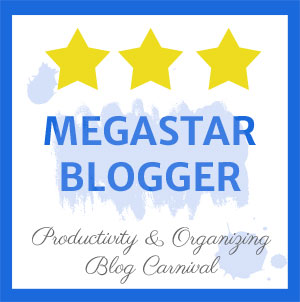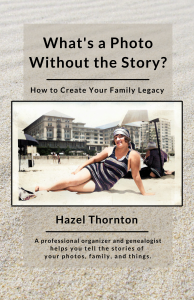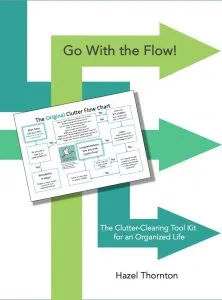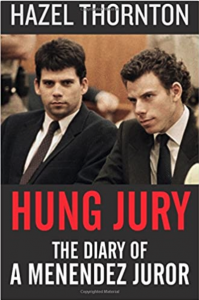More Magic Little Words (that help you get organized)

I once wrote a post called Those Magic Little Words (that help you get organized).
The point of it was that there are lots of organizing methods, and different ways of describing them — what I call “magic little words”. And the BEST method, or catchphrase, is the one that works for YOU.
Just because I’m no longer in business doesn’t mean I’ve retired from being interested in effective ways to get organized! (Once an organizer always an organizer.)
So, after you’ve read (or re-read) my previous post, I hope you enjoy this compilation of some of the more recent methods — or new ways to describe age-old methods — in case you need a fresh perspective.
Hushing the House
Aka Quieting the House, or Backwards Decluttering, this method (by this name) apparently started here: How + Why to Quiet Your House.
The idea is that you move all the items in a room to a staging area so you can clean and experience the de-cluttered room. Then you move the things back that you still need or want.
Here’s another example I Tried the “Hushing the House” Method on My Cluttered Dining Room
This method is compatible with my old post about 10 Easy Steps to a Clutter-Free Office.
Quiet Luxury
This is an interior design trend that aims to provide a serene atmosphere with neutral colors and elegant, but simple and functional, pieces.
I was asked to contribute to this article, never having heard of “quiet luxury” before. But it wasn’t hard for me to come up with some tips for “reducing visual noise” by decluttering!
5-Year Rule
The idea is this: If you haven’t used something in the past five years, it’s unlikely it will be used in the future. Therefore, it can be discarded, donated, or given away.
It’s not for memorabilia; it’s more for clothing, electronics, sports equipment, gardening tools, kitchenware, toys, etc.
What is the 5-Year Rule for Decluttering? (5 Reasons It Could Work For You)
The Moving Out Mindset
This method is, indeed, “powerful and motivating” as claimed in this article. But it’s not new, innovative, or unique except for the fact that sometimes multiple people really do come up with the same ideas, unaware of each other’s existence.
In fact, it reminds me of my old post about Home Staging to Stay, Not to Sell.
The idea is that you pretend you are moving and declutter, downsize, and clean as if you were.
Gather and Shop
This is just another way of saying: 1) gather like items together, then 2) decide which ones you want to keep. It’s the Sort/Purge part of the S.P.A.C.E. methodology.
Here’s a Instagram Reel that uses spatulas as an example. Similarly, I’ve heard (and used) “shop from your own wardrobe”. This is a useful way to realize how much you already have and extend the life of good items by combining them in ways you hadn’t considered before.
The Three Feet Rules for Downsizing
Rule #1: Look within three feet of where you spend time in your home every day. (The things that are within arm’s reach are probably things you use every day.)
Rule #2: If you haven’t come within three feet of an item in your home within the past two years it probably doesn’t need to come with you to your new place.
For more on this method click here.
The Didn’t Know Rule
This one is from The Minimalists. (And from the brains of countless professional organizers.) They understand what I’m calling “magic little words” and have come up with several of them. In fact I just noticed they are offering a free ebook called 16 Rules for living with less. (Read, then scroll past, “The Didn’t Know Rule” on this page.)
The rule: If you find something you didn’t know you owned, you can give yourself permission to let it go.
Here’s an example from Apartment Therapy: I Tried the “Didn’t Know” Rule and Decluttered So Much in 10 Minutes
DOOM Boxes
Awhile back ago I started hearing about DOOM boxes all of a sudden, as if everyone already knew what they were. I learned that DOOM is an acronym for Didn’t Organize Only Moved.
Oh, that. LOL. Even organizers occasionally sweep clutter into a box when company is suddenly coming. Ideally, they revisit the box sooner than later and put everything where it belongs.
I googled it and found this surprisingly good AI Overview:
The term “doom box” originated on TikTok and is an acronym for “didn’t organize, only moved”. It describes a temporary storage space for clutter that doesn’t have a clear place to go, such as a junk drawer, paperwork pile, or underbed storage. Doom boxes can be a convenient way to clear space, and some people may have multiple doom boxes, doom bags, or even doom rooms. The term can also describe the feeling of dread and overwhelm that comes with dealing with these collections.
Some reasons for clutter include: Anxiety or depression, Major life events, Clinging to sentimental items, Too much stuff, and Too little space. People with ADHD may be more likely to have a doom box as a way to cope with symptoms of disorganization and executive dysfunction.
This isn’t so much a method of organizing as it is, I think, a situation that is more easily avoided if named, defined, and acknowledged.
Bird by Bird
This one caught my attention because, like the author of this becomingminimalist guest post, I’m a fan of Anne Lamott’s book on writing, Bird by Bird. This method encourages you to think of decluttering as a journey at take it a step at a time. “As you finish with that first step, the next one will become apparent. Just trust the process and resist temptation to look too far ahead.”
Although I’ve never applied the phrase “Bird by Bird” to organizing, I’ve often said that organizing is a process, not an event. Similarly, I’ve written, “Think of your big project as a new hobby.”
The Poop Test
And — just in time for me to finish this post — there’s a new technique in town!
It goes like this: If it had poop on it, would you wash it off or throw it away?
I heard it first in our private NAPO chat (thanks, Lauren!), followed by a social media meme (Naomi), and this article, which, all told, make it a definite new “thing”: Sorry, Marie Kondo. This ADHD influencer’s ‘poop method’ for decluttering is brilliant and hilarious.
I shit you not! (Pun intended.)
Hey, whatever works!
Clutter Flow Charts
I suppose it would be foolish of me to not plug my own favorite decluttering method in this post:
Go With the Flow! The Clutter Flow Chart Workbook
Read more on my website <— Look for your free, downloadable, updated copy of The Original Clutter Flow Chart!
Order your copy on Amazon <— You’ve been meaning to buy it anyway, right?
What “magic little words” work for YOU?
Please share in the comments below!
______________________________________________________
- Hazel Thornton is an author, genealogist, and retired home and office organizer.
- Hung Jury: The Diary of a Menendez Juror
- What’s a Photo Without the Story? How to Create Your Family Legacy
- Go With the Flow! The Clutter Flow Chart Workbook
- Feel free to link directly to this post! Click here to ask about other uses.
- Copyright 2024 by Hazel Thornton, Organized for Life and Beyond
______________________________________________________________________________
Share this:







I love how robust this post is; all of these concepts go well beyond the kinds of magical) (and not-so-magical) organizing terms you’d previously introduced and the ones (like the OHIO rule) that I often discount. I’d not heard of DOOM boxes until a few years into the pandemic, and then only in terms of ADHD folks. I am intrigued by all of these newer names/ideas.
The Poop thing, I’d only recently heard about, and it made me role my eyes. I suspect that unless I had a baby, I’d get rid of anything that got poop on it, and even then, I might only ever keep the baby but nothing else the poop touched. I even joked when, a week after birds pooped on my brand-new car, that I needed to get rid of the car. I’m the sort of person who, if there were a mouse in my house, or a too-gigantic bug, would MOVE HOMES. So, yeah.
I can’t imagine truly hushing a house, though hushing a room might be doable.
I have a hard time imagining how much poop — and on what — prompted a whole new method of organizing, lol!
I have not heard of several of these methods—Hushing the House and Quiet Luxury—which are new to me after 19 years in the business. I’ve used something like Hushing the House but didn’t have a name for it. It’s always interesting to me what works for certain clients. I like to ask “What’s your intention?” with some objects that clients may struggle with when making decisions. It seems to work well because it stops the client from moving too quickly and making those snap decisions.
I’m glad I could introduce you to some new methods (or new ways of thinking about old methods), Janet!
The only one I’ve heard of before is (of course) clutter flow charts. It’s fascinating to read about all the different organizing methods!
Well, that’s the best one anyway. 😉
I resonate with a lot of these!
The idea of clearing the room and just sitting in it and enjoying the ‘hush’ before you reload is so fascinating. I had a client who owned multiple residences. When she left one, she moved the items to her “new” house. It was clean and serene. Very appealing to me! Then she sold another residence and brought all the stuff to her the “new” house. It became overwhelmed. I need to be patient because my idea of a desirable hush space is different than hers.
Anne Lamott is the best. I love her stuff. I do think there is something to the idea that you just start somewhere and it leads to the next step. This is sort of like life. We open one door, walk through, and then see where we go from there. The key is to walk through the door, not just crack it open, peek in, get scared, and then close the door! Renovating is like this too. You redo one space and suddenly the rest of the house looks old and tired.
The idea of considering a specific number of years is helpful, but not absolute. I have had situations where I kept an item I really loved, even though I wasn’t using it for many years. Then my situation changed in someway, and I started using it. For me, I focus more on whether I still love an item. If I do, and if having it is a priority in my life, then I keep it, whether it is active or not.
That said, electronics you haven’t touched in 5 years? Forget about them – ancient. 🙂
Glad you liked the post and commented, Seana! It’s fun to see new methods — and new ways of explaining old methods — of organizing.
I love this collection! It’s funny how specific phrases become ‘the thing’ that helps someone make decisions. And as you said, do what works. The phrases/concepts you shared are infused with humor, which is powerful.
While some of these I knew about DOOM boxes or bags, I’m unfamiliar with most of the other phrases. The concepts are familiar, though. The Poop Test made me laugh.
Hi Linda! I do think humor helps get the job done, or the routine established.
This is a really fun post. I use the term “Shit-Shifting” for the DOOM Box. Same thing.
Thanks, Ellen! Hey, whatever works!
I’ve seen a few of these and I’ve dived into them, only to think the typical S.P.A.C.E methodology is the best one. Apartment Therapy has given some of these methods visibility. Nothing matches just hunkering down and making decisions. The rest is just trendy. – John
I used S.P.A.C.E. for the entire 17 years I worked with clients (as mentioned in my original “Magic Little Words” post)! One client asked to organize ala Kondo, so I printed out the Kondo checklist of areas/types of clutter and we went in that order….applying S.P.A.C.E. as we went, lol!
Thank you. This was so much fun. I had never heard of the Hushing the House and I may have to test it for my office, nor did I know that the method I’ve been mostly using is S.P.A.C.E.
I do like Ellen’s “Shift-Shifting” term for the DOOM Box…
I may have to share your blog with my clients.
I’m glad you enjoyed it! Feel free to share!